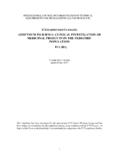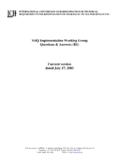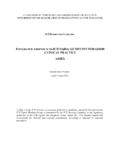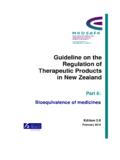Transcription of Final endorsed Concept Paper M10: Bioanalytical …
1 International Council for Harmonisation of Technical Requirements for Pharmaceuticals for Human Use ICH Secretariat, Chemin des Mines 9, Box 195, 1211 Geneva 20, Switzerland Telephone: +41 (22) 338 32 06 - Final endorsed Concept Paper M10: Bioanalytical Method Validation 7 October 2016 Type of Harmonisation Action Proposed The proposed new multidisciplinary guideline will apply to the validation of Bioanalytical methods and study sample analyses in non-clinical and clinical studies. This guideline will provide recommendations on the scientific regulatory requirements for bioanalysis conducted during the development of drugs of both chemical and biological origins.
2 This will result in the harmonisation of current regional guidelines/guidances and support streamlined global drug development. Statement of the Perceived Problem Bioanalysis herein means the quantification of drugs and their metabolites in biological matrices such as plasma, serum, blood, urine or other body fluids, which are conducted in non-clinical and clinical studies. Reliable data derived through validated Bioanalytical methods are key for the review of marketing authorisation application. In the EU, US and Japan, regulatory guidelines or draft guidances for Bioanalytical method validation (BMV) have been issued and recommendations on basic requirements are established for these nations/regions.
3 However, several differences in method validation and study sample analysis exist among these guidelines/guidances and remain hurdles for the mutual use of Bioanalytical data in global drug development. This means that sponsors, pursuing global approvals, are required to reconcile multiple guidelines/guidances in different countries and often requires unnecessary duplicative testing in order to meet the variable requirements. Current BMV guidelines/guidances: EU Guideline on Bioanalytical Method Validation (2011) US Guidance for Industry: Bioanalytical Method Validation, DRAFT (2013) Guidance for Industry: Bioanalytical Method Validation, (2001) Japan Guideline on Bioanalytical Method Validation in Pharmaceutical Development (2013) Guideline on Bioanalytical Method (Ligand Binding Assay) Validation in Pharmaceutical Development (2014) Issues to be Resolved The main technical and scientific issues in BMV can be categorized as method validation, study sample analysis and other issues as described below.
4 The recommendations provided in the guideline will address the issues by considering the characteristics of the analytical methods used in bioanalysis, , chromatographic assay and ligand binding assay. Final M10 Concept Paper endorsed : 7 October 2016 -2- 1. Method validation Define each validation characteristic ( , specificity, selectivity, calibration curve, sensitivity, reproducibility, accuracy, precision, total error, recovery, range, dilution integrity/linearity, matrix effect, carry-over, stability), their appropriate evaluation method and acceptance criteria, with respect to methods used to support non-clinical and clinical studies Clarify the cases where partial or cross validation are necessary and the validation characteristics that need to be evaluated Establish the requirements for reference standard and critical reagents Consolidate scientific experience and progress of instrumentation/technology 2.
5 Study sample analysis Establish the requirements for ensuring the validity of each analytical run ( , setting the calibration standards and QC samples and their acceptance criteria) Clarify the conditions where reanalysis can be done Establish the required percentage of samples to be tested for incurred samples reanalysis (ISR) and its acceptance criteria 3. Other issues Establish the recommended documentation of validation and study sample analysis reports This topic is not specifically relevant to any special subpopulation. Background to the Proposal During the development of chemical and biological drugs, Bioanalytical methods are used in non-clinical and clinical studies such as pharmacokinetic, toxicokinetic, bioavailability, bioequivalence, dose finding and drug-drug interaction studies, etc.
6 , in order to describe the exposure to the drugs and their metabolites. It is important that these Bioanalytical methods are well characterised throughout the analytical procedures to establish their validity and reliability and ensure reliable review of the marketing authorisation application. In order to enable the mutual use of Bioanalytical data set obtained in each region, international harmonisation of requirements for BMV is critical. Without their harmonisation, pharmaceutical companies must validate the Bioanalytical methods and analyze samples to satisfy the different requirements of the guidelines/guidances in each region, thereby causing delay in global drug development and adding additional resource and cost burden.
7 As a guideline for the validation of analytical procedures, the ICH Q2 Guideline Validation of analytical procedures: text and methodology was endorsed (Oct. 1994 / Nov. 1996) and has been used in the quality evaluation of drug substances and drug products where complex matrices are usually not included. In contrast to analyses aimed at drug quality evaluation, bioanalysis conducted during non-clinical and clinical studies deals with the analyte in very complex biological matrices such as serum, plasma or other body fluids, where variations of conditions among individuals can be quite large. Therefore, a guideline specific for Bioanalytical methods needs to be established separately from ICH Q2.
8 To date, requirements for method validation of bioanalysis and study sample analysis have been discussed and Final M10 Concept Paper endorsed : 7 October 2016 -3- BMV guidelines/guidances have been issued in each region, although there are some differences among them as described above. A harmonised BMV guideline will promote the prompt, rational and effective non-clinical and clinical studies, thereby advancing the mission of the ICH. Type of Expert Working Group Recommended The EWG will require experts in Bioanalytical methods such as chromatography-based and ligand-binding assays to be nominated from the Members and Observers in line with the applicable Rules of Procedure.
9 Timing Adoption of the topic by Approval of ICH Assembly June 2016 Adoption of Concept Paper and Business Plan by Management Committee Sept. 2016 First EWG meeting (Osaka, Japan) Nov. 2016 Adoption of Step2 a/b Document 2Q 2018 Adoption of Step4 Document 2Q 2019
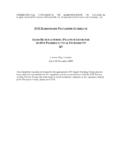
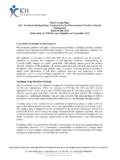
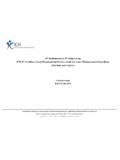
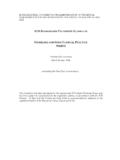
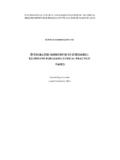
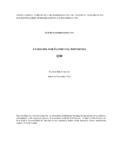
![[ICH E2F] [EXAMPLE DSUR – PHASE III …](/cache/preview/1/3/5/f/e/1/c/f/thumb-135fe1cf2cdb82799c462ad0ea089c48.jpg)
